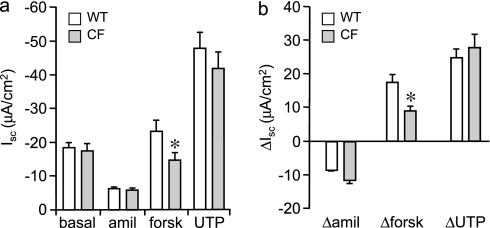Figure 1.
Electrolyte transport in primary cultures of murine tracheal epithelial cells (mTECs). After 14 days of air–liquid interface (ALI) culture, wild-type (WT) and ΔF508 cystic fibrosis (CF) mTECs were evaluated for bioelectric properties using voltage-clamped Ussing chambers. In physiological Ringer's solution, all ALI monolayers exhibited electrical resistance (600–1,500 Ω/cm2) before studies. (a) Short-circuit current (Isc) of WT and CF mTECs under basal conditions and after sequential additions of amiloride (amil; 10 μM, apical bath), forskolin (forsk; 10 μM, apical and basolateral baths), and UTP (100 μM, apical bath). (b) Changes in Isc of WT and CF mTECs in response to sequential treatments with amiloride, forskolin, and UTP. Means ± SEM are shown (n = 5–6 Transwells). *Electrophysiology of CF mTECs was significantly different from that of WT cells, at P ≤ 0.05 (unpaired Student t tests).

